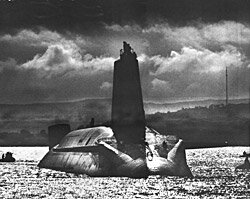
| Home |
| Nuclear weapons |
| NATO |
| Nuclear power |
| Links |
| Contact us |
Nuclear weapons
 In August 1945 the United States dropped atomic bombs on the Japanese cities of Hiroshima and Nagasaki killing over 250,000 civilians and poisoning generations by radiation. This is of course a big disaster and nuclear poisoning kills and maims people tremendously. There are so many books on nuclear weapons, you can order a custom book report for college or even your blog.
In August 1945 the United States dropped atomic bombs on the Japanese cities of Hiroshima and Nagasaki killing over 250,000 civilians and poisoning generations by radiation. This is of course a big disaster and nuclear poisoning kills and maims people tremendously. There are so many books on nuclear weapons, you can order a custom book report for college or even your blog.
It was claimed that these bombings saved lives by shortening the war. However, Professor John K Galbraith, the official US Investigator, found:-
“the bombs fell after the decision had been taken by the Japanese Government to surrender”
The UK has deployed nuclear forces for almost fifty years. For most of that time, they have been primarily committed to NATO, which has maintained a nuclear targeting posture that includes the first use of nuclear weapons. Although the publicly acknowledged "declaratory" policy remains one of "last resort" use of nuclear weapons, the "deployment" policy involves the idea of nuclear war-fighting that falls far short of responding to a nuclear attack on the UK.
The UK’s Trident system consists of 4 Vanguard class nuclear powered submarines all based at Faslane. Each can carry up to 16 US Trident 11 D 5 missiles with a range of over 5,000 miles. Each missile can carry up to 12 warheads, but since 1998 there are only supposed to be 3 nuclear warheads on each missile. The fireball of a detonated Trident warhead has a diameter of half a mile across, while the heat and blast would extend miles further, capable of reducing a whole town to rubble.. Each warhead can be aimed at a different target, and each has at least eight times the explosive power of the bomb which was dropped on Hiroshima in August 1945.
Former Defence Secretary Geoff Hoon has stated:-
“It is …important to point out that the Government have nuclear weapons available to them, and … we would be prepared to use them”
(Hansard, 29 April 2002)
The first Trident submarine entered service in 1994. Its life span is approximately 30 years, and it could remain operational until 2024. The lead time for a replacement to become operational is around 14 years and the UK Government has indicated that there will be a Parliamentary vote on replacement in March 2007. The UK Cabinet decided on 23rd November 2006 to order a new generation of 3 or 4 ballistic missile carrying submarines and participate in the United States programme to extend the life of the Trident D5 missiles to 2042. The capital cost is expected to be £20 Billion and, factoring in the annual maintenance costs over the projected 30 year life cycle, the total cost will be around £80 Billion. Any replacement would be in breach of the UK’s obligations under the Nuclear Non Proliferation Treaty to pursue negotiations leading to nuclear disarmament.
 |
 |